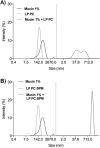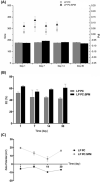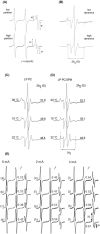Besifloxacin liposomes with positively charged additives for an improved topical ocular delivery
- PMID: 33159142
- PMCID: PMC7648625
- DOI: 10.1038/s41598-020-76381-y
Besifloxacin liposomes with positively charged additives for an improved topical ocular delivery
Abstract
Topical ophthalmic antibiotics show low efficacy due to the well-known physiological defense mechanisms of the eye, which prevents the penetration of exogenous substances. Here, we aimed to incorporate besifloxacin into liposomes containing amines as positively charged additives and to evaluate the influence of this charge on drug delivery in two situations: (i) iontophoretic and (ii) passive treatments. Hypothesis are (i) charge might enhance the electromigration component upon current application improving penetration efficiency for a burst drug delivery, and (ii) positive charge might prolong formulation residence time, hence drug penetration. Liposomes elaborated with phosphatidylcholine (LP PC) or phosphatidylcholine and spermine (LP PC: SPM) were stable under storage at 6 ºC for 30 days, showed mucoadhesive characteristics, and were non-irritant, according to HET-CAM tests. Electron paramagnetic resonance spectroscopy measurements showed that neither the drug nor spermine incorporations produced evident alterations in the fluidity of the liposome's membranes, which retained their structural stability even under iontophoretic conditions. Mean diameter and zeta potential were 177.2 ± 2.7 nm and - 5.7 ± 0.3 mV, respectively, for LP PC; and 175.4 ± 1.9 nm and + 19.5 ± 1.0 mV, respectively, for LP PC:SPM. The minimal inhibitory concentration (MIC) and the minimal bactericide concentration (MBC) of the liposomes for P. aeruginosa showed values lower than the commercial formulation (Besivance). Nevertheless, both formulations presented a similar increase in permeability upon the electric current application. Hence, liposome charge incorporation did not prove to be additionally advantageous for iontophoretic therapy. Passive drug penetration was evaluated through a novel in vitro ocular model that simulates the lacrimal flow and challenges the formulation resistance in the passive delivery situation. As expected, LP PC: SPM showed higher permeation than the control (Besivance). In conclusion, besifloxacin incorporation into positively charged liposomes improved passive topical delivery and can be a good strategy to improve topical ophthalmic treatments.
Conflict of interest statement
The authors declare no competing interests.
Figures









Similar articles
-
Liposomal voriconazole (VOR) formulation for improved ocular delivery.Colloids Surf B Biointerfaces. 2015 Sep 1;133:331-8. doi: 10.1016/j.colsurfb.2015.06.036. Epub 2015 Jun 22. Colloids Surf B Biointerfaces. 2015. PMID: 26123854
-
Ocular pharmacokinetics/pharmacodynamics of besifloxacin, moxifloxacin, and gatifloxacin following topical administration to pigmented rabbits.J Ocul Pharmacol Ther. 2010 Oct;26(5):449-58. doi: 10.1089/jop.2010.0054. J Ocul Pharmacol Ther. 2010. PMID: 20874668
-
Challenges in assessing microbial susceptibility and predicting clinical response to newer-generation fluoroquinolones.J Ocul Pharmacol Ther. 2012 Feb;28(1):3-11. doi: 10.1089/jop.2011.0072. Epub 2011 Oct 14. J Ocul Pharmacol Ther. 2012. PMID: 21999341 Review.
-
Preparation and evaluation of novel chitosan: gelrite ocular system containing besifloxacin for topical treatment of bacterial conjunctivitis: scintigraphy, ocular irritation and retention assessment.Artif Cells Nanomed Biotechnol. 2018 Aug;46(5):959-967. doi: 10.1080/21691401.2017.1349779. Epub 2017 Jul 14. Artif Cells Nanomed Biotechnol. 2018. PMID: 28708424
-
Besifloxacin ophthalmic suspension, 0.6%: a novel topical fluoroquinolone for bacterial conjunctivitis.Adv Ther. 2012 Jun;29(6):473-90. doi: 10.1007/s12325-012-0027-7. Epub 2012 Jun 20. Adv Ther. 2012. PMID: 22729919 Review.
Cited by
-
Ocular Drug Delivery: a Comprehensive Review.AAPS PharmSciTech. 2023 Feb 14;24(2):66. doi: 10.1208/s12249-023-02516-9. AAPS PharmSciTech. 2023. PMID: 36788150 Review.
-
Ion-paired moxifloxacin nanocrystal formulation improves treatment and prevention of ocular infection.J Control Release. 2025 May 10;381:113634. doi: 10.1016/j.jconrel.2025.113634. Epub 2025 Mar 15. J Control Release. 2025. PMID: 40096866
-
Besifloxacin Nanocrystal: Towards an Innovative Ophthalmic Preparation.Pharmaceutics. 2022 Oct 18;14(10):2221. doi: 10.3390/pharmaceutics14102221. Pharmaceutics. 2022. PMID: 36297656 Free PMC article.
-
Drug Delivery Challenges and Current Progress in Nanocarrier-Based Ocular Therapeutic System.Gels. 2022 Jan 28;8(2):82. doi: 10.3390/gels8020082. Gels. 2022. PMID: 35200463 Free PMC article. Review.
-
Ocular Drug Delivery: Advancements and Innovations.Pharmaceutics. 2022 Sep 13;14(9):1931. doi: 10.3390/pharmaceutics14091931. Pharmaceutics. 2022. PMID: 36145679 Free PMC article. Review.
References
Publication types
MeSH terms
Substances
LinkOut - more resources
Full Text Sources
Other Literature Sources
Medical
Research Materials

